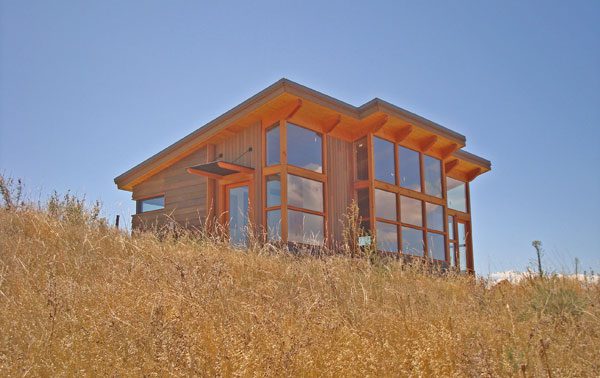Last updated on May 31st, 2024 at 08:32 am
There is a growing trend across the country towards building green. But when people think about reducing their carbon footprint in a custom home, they often think about producing renewable energy on their property. Of course, if you can do this with solar panels, a small windmill, or geothermal heat – great! But for many of us, this might not be an option.
And in fact, making your home energy efficient is actually the most cost-effective strategy to save energy. Buildings alone are responsible for around 40% of the total energy used in the country. Reducing the energy your home needs is a big step in doing your part to reduce climate change. Today, it is even possible to build a Net Zero Energy home. While the suggestions below may not make your home 100% energy efficient, you can reduce your energy needs significantly with these 8 simple suggestions. Not only will making your home more energy efficient be better for the environment and reduce your monthly utility bills, but it will also increase your home value.
1) Passive Solar Heating Home Orientation
2) Regulate Passive Solar Heating by Season
3) Design a Compact Layout
4) Insulate Your Home Properly
5) Energy-Efficient Windows and Doors
6) Energy-Efficient Lighting
7) Energy-Efficient HVAC Systems
8) Use Smart Thermostats
9) Install Energy Efficient Appliances
1) Passive Solar Heating Home Orientation
Orienting your home properly is one of the best ways to make it energy efficient. Reduce energy bills by positioning your home to maximize passive solar heat. Simply put, a passive solar home collects the sun’s heat through south-facing windows. A properly insulated home (more on this later) retains this heat and reduces your energy needs. To use passive solar heating, design many large windows that face within 30 degrees of true south into your custom home design.

Image courtesy of Tiny House Blog
To use passive solar heating, design many large windows that face within 30 degrees of true south into your custom home design.
How much you can save with passive solar heating depends on many factors: climate, location, and the design of the rest of your home. Green Building Advisors estimate that, when combined with an airtight building envelope, passive solar design can be a “cost-effective way of reducing heating costs by 40% to 90% while providing abundant daylighting and a better connection to the outdoors.”
Orienting your home for passive heat also takes advantage of natural light. By reducing your need for artificial light, your energy bill will go down even further!
2) Regulate Passive Solar Heating by Season
Of course, orienting your home for passive solar heating also means you may get too much sunlight, and therefore heat, in the summer months. To get the most out of passive solar heating, consider the following:
- Plant a deciduous tree in front of your south-facing windows. This will reduce sunlight during summer when the tree is in full bloom and help prevent your home from overheating. In the colder months, the tree loses its leaves and still allows your home to get maximum solar heat.

Image curtesy of University of Missouri Extension
- Build sun shades, awnings, or a roof overhang. These design elements can block the sun in the summer when it is higher in the sky. During winter the sun comes from a lower angle and will not be obstructed.
- Limit west facing windows. These can let in too much heat in the summer. If your design features many windows in the west, plant trees to shade the windows and block excessive sunlight.
3) Design a Compact Layout
Another often overlooked but simple way to save energy with your home design is its layout. Reduced surface area reduces interior heat loss. Spread out homes will lose more heat and be less efficient than those with a compact layout. Specifically, cube and spherical shaped homes are very efficient. Taller homes are often more efficient than spread out one-stories. Designing a home with this in mind is one of the easiest ‘once-off’ ways to increase energy-efficiency.
Virginia Polytechnic Institute and State University advises:
“Houses with simple, compact shapes, when properly designed, are more energy efficient than irregularly shaped homes. A house with a simple shape has a smaller surface area and has less exposure to the outside elements of sun, rain, and wind. It gains less heat in the summer and loses less heat in the winter. It also uses fewer building materials.”
Of course, what layout and shape you can build your home will depend on your lot, local regulations, and individual needs. Discuss with your architect how to design a layout that gives you what you need, while also taking advantage of this easy way to save energy.

Image courtesy of Advanced House Plans

Image courtesy of the house plan shop
4) Insulate Your Home Properly
According to the American Chemistry Council, as much as 40% of a building’s energy is lost due to air infiltration. Close up all the openings and penetrations in your walls and roof to keep warm air in during winter, and hot air out in summer. Proper insulation will lower the energy lost, and decrease your utility bill.
The most common and cheapest form of insulation is fiberglass, but it is also the least effective. On average, 30% of heat or air conditioning escapes where fiberglass insulation is installed. There are many types of energy-efficient insulation, and what is most appropriate for your home will depend on your climate.
One of the most recommended energy-efficient insulations is spray foam. It prevents almost all air leakage and can fit into nooks and crannies that fiberglass cannot. Fiberglass insulation is less expensive, costing roughly $0.40 per a square foot, while spray foam can cost around $0.44 to $0.65 per board foot of open-cell (some air leakage) or $1 to $1.50 per board foot of and closed-cell (no leakage). However, Home Advisor claims that “when done properly, spray foam can save you as much as $500 a year in energy costs.” Plus, spray foam insulation also adds to your home’s value: it lasts more than 80 years, compared to 10-25 years for fiberglass. And, it adds structural integrity to your home.
“Spray foam insulation contributes to industry sustainability goals by providing multiple functionality in a single product that addresses several sustainability measures. Thermal performance, air sealing, comfort, moisture control, storm resistance and structural enhancement can all be improved when you use spray foam insulation.” – Xuaco Pascual, Global Marketing Manager—Foam Insulation, Honeywell
5) Energy-Efficient Windows and Doors
Use energy-efficient windows and doors to ensure you don’t lose the benefits of properly insulating your home. These should seal openings tightly and have proper weather stripping. This may be more expensive upfront, but using inefficient products could cost you more in the long term. Plus, energy-efficient windows and doors increase your home’s value.
Government-rate Energy Star windows, doors, and skylights offer a great value. Energy Star windows can lower your home’s energy bills by 23% and save $101–$583 on average every year. That’s a total of 1,006–6,205 pounds of CO2 annually compared to standard single-pane windows!

Image courtsey of Energy Star
6) Energy-Efficient Lighting
According to The U.S. Energy Information Administration, light accounts for a shocking 14% of the electrical budget on an average home. So when artificial lighting is necessary, use ones that increase energy efficiency and reduce your energy bill. CFLs and LEDs use 25-80% less energy than traditional incandescent bulbs and last 3-25x longer, according to the US Department of Energy. So while traditional incandescent bulbs may cost $1-$3, they will only last 1-3 years. In contrast, a LED bulb cost $4-$25 but will last 10-25 years.
Now let’s compare actual energy costs, based on average data from the US Department of Energy:
-
- One 60W Traditional Incandescent bulb cost $4.80 in electrical costs annually and has about 1000 hours of life.
- One 43W Energy-Saving Incandescent bulb costs $3.50 a year and lasts 1,000-3,000 hours.
- In contrast, one 12W LED bulb costs $1 a year and lasts about 25,000 hours.
That’s an annual electrical saving of up to $3.80 for each light. Just how much energy you save in total will depend on the number of lights in your home.
Energy-efficient options may cost more upfront, but the long-term energy savings and less frequent bulb changes justify the costs. Plus, prices have fallen sharply in the past few years and are now “too cheap to ignore,” as put by WIRED.
“Overall, now that LED retail prices have come down so substantially, there isn’t much debate about which option provides more value. Clearly, in this instance, paying a little more upfront will save you money in the long run.”– Brad Tuttle at Time Magazine’s ‘Money’ s
7) Energy-Efficient HVAC Systems
The systems that go into your home are just as important as the structural design. The U.S. Department of Energy estimates that heating and cooling account for about 48% of the energy use in a typical U.S. home. So this is clearly a key area to save energy and money with your custom home build.
Consider an Energy Recovery Ventilator (ERV). That’s basically a fancy name for a system that reduces energy usage on your HVAC. It recycles air from your home’s exhaust fans and ducts to preheat or precool air coming into your home.
“The energy savings pays for the rest of the initial investment within a relatively short timeframe—the payback period ranges from 3 months to 3 years for most systems, depending on the size of the system and the building’s geographic location. The ERV then continues to provide the owner with a positive cash flow over the life of the system, which typically is more than 20 years.” – Ryan R. Hoger at ECObuilding Pulse
Also look into high-efficiency heat pumps. Heating and air conditioning are typically the largest consumers of energy in a home. An efficient HVAC system can save you tons of energy, and therefore money on your monthly bill. Consider an air-source heat pump. According to the Department of Energy, heat pump can reduce the electricity used for heating by about 50% compared to electric resistance (such as furnaces and baseboard heaters). Annual savings in the Northeast and Mid-Atlantic are around $459 and 3,000 kWh of energy compared to electric resistance heaters and $948 and 6,200 kWh of energy compared to oil systems.
8) Use Smart Thermostats
Smart or programmable thermostats are a simple system that can be added to your HVAC design that can save you a lot of energy. This technology turns on/off heating and air conditioning when the temperature in your home passes a certain threshold and can be programmed to turn your systems down at night or during the day when you are not in the house. Energy Star estimates that programmable thermostats can reduce typically energy costs by $180 annually.
Another suggestion is to split your home into zones. This way, you can regulate the use of heat and air conditioning in different areas of the home based on needs at different times. This way, you won’t be wasting energy cooling down your attic when you aren’t using it, or heating up your basement when no one is down there.

Image courtesy of My Air One
9) Install Energy Efficient Appliances
Lastly and perhaps the most obvious way to increase the energy-efficiency in your home is to use energy efficient appliances, particularly in your kitchen. This is a must if you want to take advantage of all the other energy-efficient aspects of your home. Home appliances like refrigerators laundry machines account for about 13% of your electrical usage. Look for Energy Star rated appliances to get started. These laundry machines and refrigerators are about 20% more energy efficient than standard market models.




